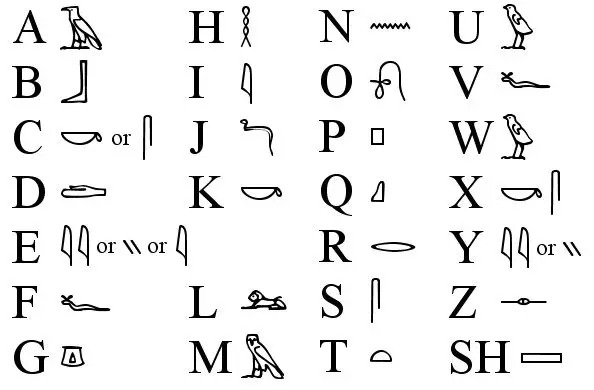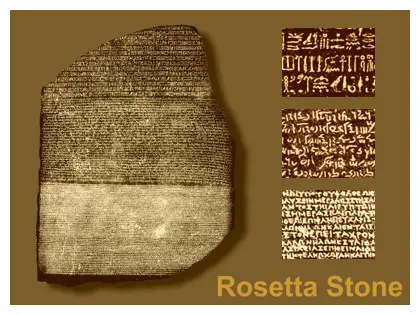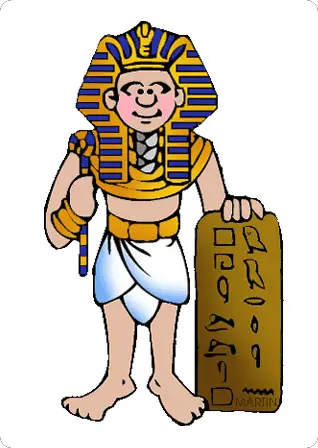Ancient Egyptian Alphabet
What was the Ancient Egyptian alphabet?
Even though it wasn’t used much by the commoners of Egypt, the system of ‘hieroglyphics’ is what we know today as the Ancient Egyptian alphabet.
The hieroglyphic system of writing was first used around 3000 BC, and is one of the oldest writing systems historians have discovered how to translate.

What made the Ancient Egyptian Alphabet different from other writing systems?
In the hieroglyphic system, instead of each letter (or character) representing part of a word, each hieroglyph represents a whole word.
For example, instead of four symbols spelling B-I-R-D for the word bird, there would just be one; and it was probably just a picture of a bird!
But hieroglyphs often had double meanings or symbolic importance; and because there were thousands of symbols and even more ways to interpret them, the language was complex to learn and translate.
What makes the language even more confusing is that hieroglyphic messages could be written in any direction: right to left, left to right, top to bottom, bottom to top, or even in circles!
The reader of the hieroglyphic message would figure out the direction of the writing based on what way the hieroglyphics (mainly the ones with eyes) were facing.
By seeing which direction these living symbols were facing, you could determine the direction you were supposed to read in.
The system also had no punctuation at all, and therefore no full stops (periods) or commas to form sentence breaks.
At the time, this would have made the messages confusing to read; which wasn’t helped by the fact that hieroglyphs could stand for a complete word (an “ideogram”) or just a part of one (a “phonogram.”)
Multiple phonograms would add up to a single word (which is kind of like the English alphabet we use nowadays!) by chaining multiple “sounds” or syllables together.
Was it hard to learn hieroglyphics?
Hieroglyphics were very hard to learn. Because each hieroglyph had a unique meaning, students would have to memorize each one individually if they wanted to be fluent!
Because of this, it took many years to learn how to read (and write) hieroglyphics.
Those who were trained to do this were called scribes, and would start their training between the ages six and seven.
Despite how difficult it was to learn hieroglyphics, there were still many who chose to become scribes.
This is because the profession was treated with great respect in Ancient Egypt… but only wealthy children were given the chance to train as scribes.
Otherwise, everybody would have done it! It was a much cleaner job than being a farmer or soldier, and had the added benefit of tax exemption (being able to skip paying tax to the government.)
Because hieroglyphics were so hard to learn, another form of Egyptian writing developed for commoners to use called the “hieratic” system.
“Hieratic” writing was sort of like hieroglyphics, but had fewer symbols and was simpler overall. Eventually, the “demotic” writing system was developed, which used no pictures at all, and was closer to the writing systems of ancient Europe and Asia than the traditional hieroglyphic system.
What were hieroglyphics used for?
Hieroglyphics were used for ceremonial purposes (in rituals and religious ceremonies such as funerals or weddings) and in official communications between the pharaoh and their court.
Hieroglyphics were also used to write protection spells on the tombs of pharaohs and other wealthy dead people.
Hieroglyphics were also very important to the practice of magic in Ancient Egypt.
Although Ancient Egyptian magic also required other religious objects and magical items (like talismans, dolls, gemstones, or statues), none would work without an ‘incantation’, or magical chant, written on papyrus.
These incantations were usually written in the holy language of the hieroglyphics, and recorded for generations to read and use.
Many of these incantations have been discovered by historians, and they tell us a lot about Egyptian faith and worship practices.

How did historians learn what each hieroglyph meant?
Because of how complex a writing system it was, nobody could read hieroglyphics for nearly 2000 years after the end of Ancient Egyptian civilization.
Despite huge amounts of time being dedicated to the field of research, no breakthrough came in the translation until the discovery of the Rosetta Stone in 1799.
Using the artifact, a French scholar named Champollion worked out what each symbol of the system meant and how their meaning was chosen.
The upper part of the Stone had a message written in hieroglyphics, with the same message repeated in “demotic” (the easiest form of Egyptian writing) and then Greek.
This Rosetta Stone was used as a reference to translate the hieroglyphic system; and because of this, the Rosetta Stone is one of the most important discoveries from Ancient Egypt.

Facts about hieroglyphics:
- The characters of the Ancient Egyptian alphabet were called ‘hieroglyphs.’
- The ‘hieroglyphic’ system of writing was made up of thousands of hieroglyphs.
- Due to how difficult the language was to learn, multiple writing systems were developed that became common among the lower classes: hieratic, for priests and religious figures, and demotic, the kind used by the public.
- However, hieroglyphs were always used in official government documents, and had a secondary purpose for protection spells and religious rituals.
- Historians discovered to read hieroglyphs using an artefact called the Rosetta Stone, which had one message written in three different languages – demotic, hieroglyphic, and Greek.
- In Ancient Egypt, the people who dedicated their lives to learning hieroglyphics were called ‘scribes.’ The job was only available to children born into wealthy families, and people in the position were treated with great respect.
- It was possible for hieroglyphic messages to be written in any direction, including up-to-down or left-to-right. A reader would know the direction to read in by the angle of the symbols, and which way the birds/people drawn were facing! For example, if the hieroglyph of a man was facing upwards when drawn, the message would have to be read from bottom-to-top.
What did you learn:
What was the name of the artifact which first allowed historians to translate hieroglyphics?
The Rosetta Stone.
What job was given to the wealthy children of Egypt who learnt to read and write hieroglyphics?
Scribes.
Name two uses of hieroglyphics in Egypt.
Ceremonial purposes (burials, weddings, births) and official documentation (legislation, tax declarations.)
How would an Egyptian figure out the intended reading direction of a hieroglyphic message?
By looking at how the hieroglyphs were angled/which way any ‘living symbols’ like animals or people were facing.
What does the word hieroglyph mean?
Holy carving.



